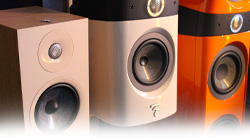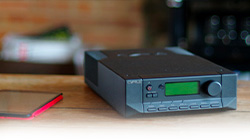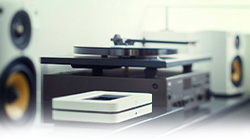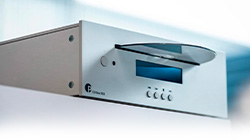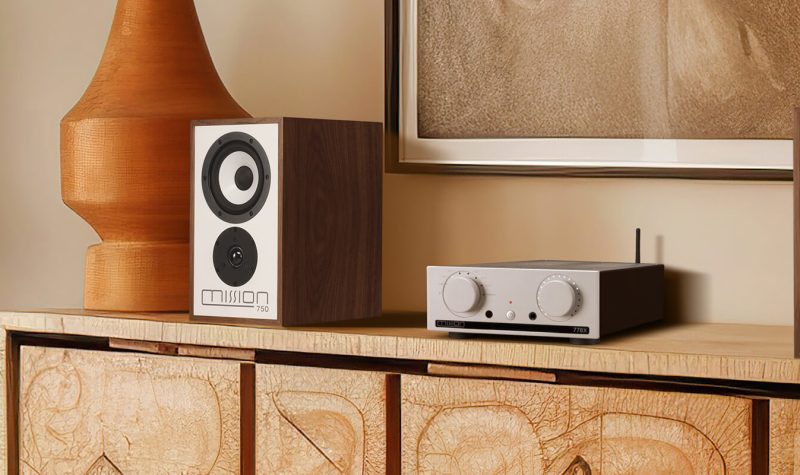
The Hi-Fi amplifier is the heart of any hi-fi system. With so many models available and complex technical specifications, choosing the right amplifier can be tricky. This guide will guide you step by step through this crucial decision for your audio system.
What is a HiFi integrated amplifier and why is it essential?
A Hi-Fi integrated amplifier, as its name suggests, amplifies low-level audio signals from your sources (turntable, CD player, streamer) into signals powerful enough to power your speakers. Without an amplifier (and phono preamplifier), the signal delivered by a turntable (a few millivolts) would remain completely inaudible.
The role of the integrated amplifier in your audio system
The integrated amplifier performs two main functions:
- Preamplification: raises very weak signals to standardized line level
- Power amplification: provides the energy needed to move the speaker membranes
This dual mission explains why the amplifier directly influences the sound quality of your setup. A great amplifier unlocks the potential of modest components, while an unsuitable model degrades even the most refined sources.
Integrated amplifier vs. separate components: which to choose?
The integrated amplifier: the all-in-one solution
The integrated amplifier combines preamplification and power amplification in a single package. This approach has several advantages:
- Ease of installation: only one device to connect
- Reduced footprint: ideal for limited spaces
- Value for money: generally more affordable
- Less wiring: simplified installation
The separate elements: audiophile excellence
The separate configuration (preamplifier + power amplifier) is aimed at higher-end installations:
Benefits :
- Isolation of sensitive circuits
- Optimized signal-to-noise ratio
- Modularity and scalability
- Superior audio performance
How to determine the required power?
An amplifier’s power is measured in watts RMS (continuous power), which is more meaningful than peak power for everyday use.
Amplifier-speaker matching rule
| Nominal speaker power (W RMS) | Recommended amplifier power (W RMS) |
| 50 W | 75 – 100 W |
| 75 W | 110 – 150 W |
| 100 W | 150 – 200 W |
| 150 W | 225 – 300 W |
| 200 W | 300 – 400 W |
Factors influencing the choice of power
- Speaker performance: High efficiency speakers (>90 dB) require less power than a less sensitive model below 89 dB.
- The size of the room: A large room or living room with cushioning surfaces will require more power.
- The musical style: Classical music with its large formations and great dynamics requires more power reserve than pop or electronic music.
Amplification classes explained
The amplification class determines the operating mode and sonic characteristics of your amplifier.
Class A: absolute sound purity
Principle: The output components conduct continuously, even without signal.
Benefits :
- Almost non-existent distortion
- Warm and natural sound
- Exceptional musicality
Typical use: High-end tube or transistor amplifiers for demanding audiophiles
Class AB: the perfect balance
Principle: Compromise between classes A and B with maintenance of a low quiescent current. In general, 30% of their nominal power is available in class A.
Benefits :
- Excellent sound quality
- Correct yield (50-60%)
- Versatility of use
- Moderate heating
Typical use: Majority of HiFi and home cinema amplifiers
Class D: modern efficiency
Principle: Amplification by switching with pulse width modulation (PWM), called digital.
Benefits :
- Very high yield (>90%)
- Compactness and lightness
- Minimum heating
- High power in small volume
Typical use: Connected amplifiers, portable systems, modern installations
Phono input: essential for the turntable
If you own or are considering purchasing a turntable, the phono input becomes essential.
Why a specific phono input?
The signal delivered by a phono cartridge is extremely weak and requires:
- Specific amplification (high gain)
- Applying the RIAA equalization curve
Types of phono cartridges
| Characteristic | Cellule MM | Cellule MC (low level) | Cellule MC (high level) |
| Output level | High (~5 mV) | Very low (~0.1-0.5 mV) | Medium (between 1 and 2.5 mV) |
| Required gain | Low (40 dB) | High (~58-70 dB) | Medium (48-52 dB) |
| Sound quality | Good, versatile | Outstanding | Excellent |
| Price | Affordable (35-500€) | High (300-5000 €) | Medium (400-1200 €) |
What technical specifications should be analyzed?
Total Harmonic Distortion (THD)
THD measures the distortion added to the original signal. A value less than 0.1% indicates excellent reproduction fidelity. A high THD results in a loss of clarity, particularly audible on high-pitched instruments.
Signal-to-Noise Ratio (SNR)
Expressed in decibels, SNR quantifies the difference between the useful signal and the background noise. The higher this value (>90 dB), the more your amplifier reveals subtle nuances and delicate passages.
Frequency response
A linear response from 20 Hz to 20 kHz ensures faithful reproduction of the entire audible spectrum. Significant variations in this range color the sound.
Output impedance
The output impedance must be compatible with your speakers (4, 6 or 8 ohms). Incompatibility can lead to overheating and risk of damage.
Questions to ask yourself before purchasing
1. What are my musical sources?
- Turntable: phono input required
- Streaming: amplifier with integrated DAC or wireless connectivity
- CD/SACD: digital inputs (optical, coaxial)
- Sources multiples: multiple entries required
2. Where and how will I listen?
- Room size: influences the power required
- Acoustic treatment: impact on perceived performance
- Usual listening volume: determines power requirements
3. What is my budget and my career prospects?
- Budget initial: determines the accessible range
- Scalability: possibility of adding sources or changing speakers
- Warranty and after-sales service: sustainability criteria
4. What sound signature are you looking for?
- Warm sound: tube amplifiers, class A
- Neutrality: transistor amplifiers, class AB
- Dynamic: powerful amplifiers with good headroom
Common mistakes to avoid
Relying on power alone
Power isn’t everything. The amplifier’s headroom (VA) is just as important. Watts can be compared to a car’s horsepower, and VA to its torque. Interaction with your speakers, build quality, and sonic signature are just as important.
Neglecting room acoustics
A poorly acoustically treated room compromises the performance of even the best amplifier and speakers. Add rugs, curtains, and furniture to improve acoustics.
Choose only on specifications
Technical measurements can guide the choice but cannot guide the choice alone. This must be guided by the speakers in the room and personal tastes in terms of reproduction (timbre, transparency, dynamics, etc.).
Forgetting the quality of the electric current
The amplifier is very sensitive to the quality of the mains power. A quality mains cable offering excellent performance and in correlation with the amplifier’s range will optimize the reproduction.
Forget the break-in period
A new amplifier requires several hours of operation to reveal its true potential. Don’t judge its performance too harshly right away.
Budget Buying Guide
Beginner budget (€300-800)
Desired characteristics :
- Integrated amplifier
- Built-in phono input
- Suitable power (50-100W)
- Recognized brands
Our recommendations:
ROTEL A08: 30W integrated amplifier with an MM phono input and a headphone output. This simple amplifier offers excellent musicality and reproduction. It offers excellent transparency and superb dynamics while prioritizing finesse and clarity.
Mission 778X: 60W per channel integrated model, renowned for its musicality and excellent value for money. Its British design prioritizes musical consistency and ease of use, ideal for beginners in hi-fi.
Musical Fidelity B1xi : Compact 75W amplifier with an elegant design, inheriting Musical Fidelity’s know-how. It delivers detailed and dynamic sound in a small format, perfect for limited spaces without compromising on quality.
Benefits :Optimized price-performance ratio, ease of use
Intermediate budget (€800-2000)
Desired characteristics:
- Best construction
- Strong sound signature
- Extended connectivity
- Integrated DAC possible
Our recommendations:
Audiolab 6000A MkII: Modern 75W amplifier with integrated high-resolution DAC and MM/MC phono input. Its exceptional versatility and technical performance place it among the benchmarks in its category. Ideal for a scalable installation.
Rega Brio MK7 : The latest evolution of the renowned Brio, delivering 50W with Rega’s signature sonic purity. Its natural synergy with Rega turntables and minimalist construction prioritize signal quality. A favorite choice for music lovers.
Musical Fidelity A1 : Reissue of a high-fidelity legend! This amplifier works entirely in pure Class A and offers a high current capacity. It is equipped with an excellent MM and MC phono input! The restitution shows no aggressiveness or harshness while remaining dynamic. The midrange is present with this transparency and this substance specific to amplifiers operating in Class A.
Benefits :Significant audible differences, increased versatility
Budget premium (€2000 plus)
Desired characteristics:
- Separate elements possible
- Advanced Topologies
- Premium finishes
- Exceptional performance
Our recommendations:
Rega Elicit MK5: 105W integrated amplifier embodying Rega excellence. Its unique topology and uncompromising construction deliver exceptional musicality. Its integrated MM/MC phono stage makes it a perfect choice for discerning vinyl players.
Atoll IN400 EVO: The flagship of the French brand, this 200W integrated amplifier combines power and finesse. Its fully analog design and carefully selected components guarantee a stunningly natural reproduction. An exceptional amplifier for a prestigious installation.
Aurorasound HFSA-01: 18w tube amplifier with remarkable musicality. It is equipped with a superb phono input (with EQ Decca, Columbia, 78SP …). It offers a sublime midrange thanks to its transparency, neutrality and uncommon realism on voices. The treble reaches very high with a surprising softness and finesse. The bass is superb in its articulation and precision while remaining very organic. A “Magic” amplifier
Benefits :Sound excellence, sustainable investment
FAQ: Frequently Asked Questions
Do I really need an amplifier for my turntable?
Yes, absolutely. An amplifier with a phono input if the turntable doesn’t have a phono preamp.
What is the difference between a HiFi amplifier and a home cinema amplifier?
A Hi-Fi amplifier prioritizes stereo sound quality, while a home cinema amplifier manages multichannel (5.1, 7.1) and generally has a digital preamp and a lot of DSP which harms the reproduction.
For pure music listening, a stereo HiFi amplifier generally offers better performance.
Is a more powerful amplifier always better?
No. The power must be appropriate for your speakers and your home use. An amplifier that is too powerful for very sensitive speakers can generate hiss, while an undersized model generates distortion and could damage the speakers.
How do I know if my speakers are compatible?
Check the impedance (4, 6, or 8 ohms) and power rating of your speakers. The amplifier must support this impedance and ideally deliver 1.5 to 2 times the speaker’s power rating.
Should we favor tubes or transistors?
Tube amplifiers offer a sound often described as natural and more timbre-rich while being more realistic. However, they require more maintenance. Tubes require replacement after 2500 to 5000 hours of use. Solid-state amplifiers offer a more “straightforward” sound, are maintenance-free, and can be less demanding.
How to properly combine amplifier and speakers?
Successful matching depends on three factors: impedance compatibility, power matching, and harmony of sound signatures…
Choosing a HiFi amplifier requires balancing technical aspects with personal preferences. This central component of your audio system deserves special attention because it directly influences your daily listening pleasure. Take the time to analyze your needs, test different models, and don’t hesitate to seek expert advice to make the choice that will accompany you for many years to come.





